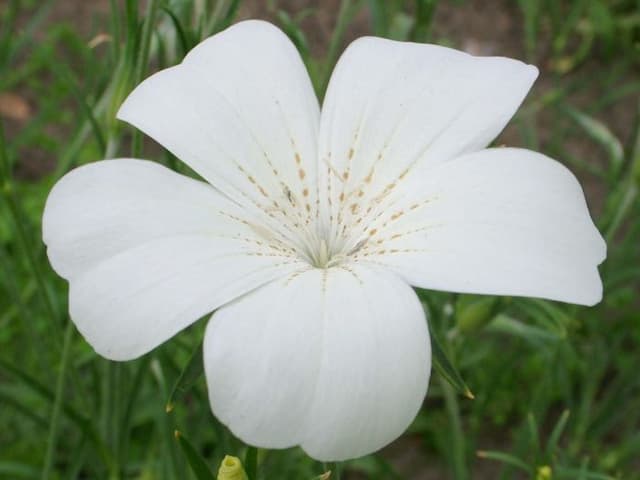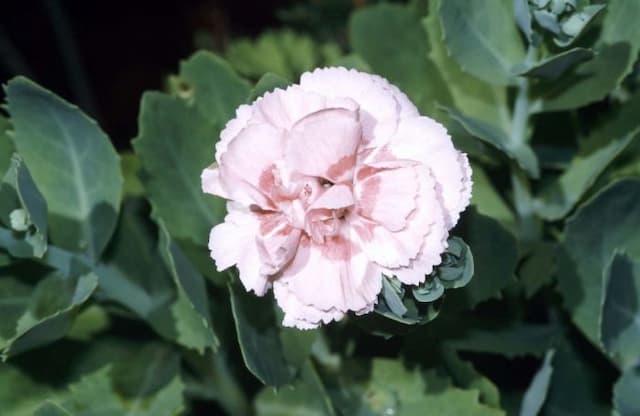Pink Dianthus 'Trisha's Choice' (p)

ABOUT
Dianthus 'Trisha's Choice' is a cultivar that is known for its charming and colorful appearance. It typically produces a wealth of small, yet visually striking flowers. The petals of these blossoms are often a vibrant pink or rich red hue, with intricately fringed edges that give each flower a delicate, lacy look. Sometimes, the petals may exhibit two tones, with a darker center or eye that fades to a lighter edge, increasing the visual interest. The center of the blooms commonly features a contrasting color, usually in a deeper or more intense shade than the petals, which makes the center stand out and draws the eye. The foliage of this particular Dianthus is usually a grayish-green to blue-green color and forms a compact cushion or tuft that serves as a background for the vibrant flowers. Leaves tend to be slender and may have a slightly glaucous or waxy coating, giving them a matte appearance. Overall, the plant has a neat and tidy habit, with the flowers often held on sturdy stems just above the foliage, ensuring that the floral display is prominent and can be enjoyed to its fullest.
About this plant
 Names
NamesFamily
Caryophyllaceae
Synonyms
Pink, Carnation, Sweet William
Common names
Dianthus 'Trisha's Choice'
 Toxicity
ToxicityTo humans
Dianthus 'Trisha's Choice' is more commonly known as carnation. Carnations are generally considered non-toxic to humans. Ingesting parts of the plant typically does not lead to serious poisoning. However, some people might have a mild allergic reaction or experience gastrointestinal upset if they consume parts of the plant.
To pets
Carnation is the common name for Dianthus 'Trisha's Choice.' The carnation is also generally considered non-toxic to pets. It's not expected to cause serious harm if pets ingest parts of the plant. However, as with humans, some pets might experience mild gastrointestinal upset.
 Characteristics
CharacteristicsLife cycle
Perennials
Foliage type
Evergreen
Color of leaves
Blue-green
Flower color
Pink
Height
1 foot 2-3 inches (35-40 cm)
Spread
1 foot (30 cm)
Plant type
Herb
Hardiness zones
5
Native area
Europe
Benefits
 General Benefits
General Benefits- Attractive Flowers: Dianthus 'Trisha's Choice' produces beautiful, colorful blooms which are aesthetically pleasing and often fragrant, adding sensory appeal to gardens.
- Easy to Grow: This variety is known for its ease of cultivation, making it suitable for beginner gardeners or those looking for low-maintenance plants.
- Drought Tolerance: Once established, it has a good tolerance to dry conditions, requiring less frequent watering than many other garden plants.
- Pest Resistance: Dianthus generally has a natural resistance to many pests, reducing the need for chemical insecticides.
- Long Blooming Season: With proper care, Dianthus 'Trisha's Choice' offers a long blooming season, providing extended color in the garden.
- Versatility: It can be used in a variety of garden settings, including borders, rockeries, and containers, offering design flexibility.
- Attracts Pollinators: The flowers attract beneficial insects such as bees and butterflies, supporting local ecosystems.
- Cold Hardy: The plant is tolerant of cooler temperatures and can survive in many climates, making it suitable for a range of geographic locations.
- Compact Size: Its relatively small size makes it suitable for gardens where space is at a premium or for growing in pots.
- Cut Flowers: The blooms of Dianthus 'Trisha's Choice' can be cut and used in floral arrangements, bringing the beauty of the garden indoors.
- Deer Resistance: Often the plant is resistant to deer, which can help to reduce damage in areas where deer are a common garden nuisance.
 Medical Properties
Medical PropertiesThis plant is not used for medical purposes.
 Air-purifying Qualities
Air-purifying QualitiesThis plant is not specifically known for air purifying qualities.
 Other Uses
Other Uses- Dianthus 'Trisha's Choice' can be used in potpourri for its lasting fragrance. The dried petals retain their scent and can freshen up drawers and closets.
- The edible flowers of the Dianthus can be crystallized and used to decorate cakes or desserts, adding a touch of elegance to culinary creations.
- This plant can serve as a natural dye source. The flowers, when boiled, can impart a subtle pink hue to fabrics or homemade crafts.
- The Dianthus can be used as a natural pest repellent in gardens due to its strong scent, which deters certain insects from other nearby plants.
- These flowers are used in traditional sachets; their dried petals can be sewn into small pouches to scent linens and clothing.
- Dianthus petals can be added to homemade soaps for their fragrance and for a touch of natural color and texture.
- The plant's flowers can be incorporated into creative table settings or floating in decorative water bowls for special events to add natural allure.
- Dianthus flowers are used in making flavored syrups for cocktails or non-alcoholic beverages for a subtle floral hint.
- The blooms can be pressed and used in botanical art or herbarium collections as a representation of the species for educational or decorative purposes.
- The ground cover provided by Dianthus can be used in landscape design to stabilize soil and reduce weed growth in garden beds.
Interesting Facts
 Feng Shui
Feng ShuiThe Dianthus is not used in Feng Shui practice.
 Zodiac Sign Compitability
Zodiac Sign CompitabilityThe Dianthus is not used in astrology practice.
 Plant Symbolism
Plant Symbolism- Love: Dianthus flowers, also known as "pinks," are often associated with the theme of love, likely due to their vibrant colors and pleasing fragrance, which are traditionally linked to feelings of affection.
- Admiration: The striking appearance of the Dianthus 'Trisha's Choice' can symbolize admiration, representing a deep sense of wonder and esteem for someone's qualities.
- Boldness: The vivid hues and the often spicy scent convey a message of boldness and challenge, echoing the plant’s ability to stand out in a garden setting.
- Divine Favor: In historical contexts, the Dianthus was believed to be a favored flower of the gods, carrying with it divine favor and approval.
 Water
WaterDianthus 'Trisha's Choice', commonly known as Trisha's Pink Dianthus, should be watered thoroughly once the top inch of soil feels dry to the touch. Ensure the water penetrates deeply into the soil to encourage root development, but avoid overly saturating the soil as this plant does not like to sit in waterlogged conditions. Depending on the climate and soil drainage, this may translate to around 1 gallon of water every 7-10 days during active growing seasons. During the winter or in cooler temperatures, reduce the frequency to every 10-14 days, ensuring the soil does not completely dry out.
 Light
LightTrisha's Pink Dianthus thrives in full sun conditions, where it can receive at least 6 hours of direct sunlight daily. The best spot for this plant would be an area that gets unfiltered sunlight for most of the day. Avoid shady spots as inadequate light can result in poor blooming and leggy growth.
 Temperature
TemperatureTrisha's Pink Dianthus is adaptable to a wide range of temperatures but performs best in moderate conditions between 60 and 75 degrees Fahrenheit. It can survive minimum temperatures down to about 40 degrees Fahrenheit and can tolerate highs up to about 85 degrees Fahrenheit. However, prolonged exposure outside of its ideal temperature range can stress the plant.
 Pruning
PruningPrune Trisha's Pink Dianthus to promote bushier growth, remove dead or faded flowers, and maintain a compact shape. Deadheading, or removing spent blooms, should be done regularly throughout the blooming season to encourage more flowers. Cut back the foliage by one-third in early spring or after the first flush of blooms has faded to rejuvenate the plant and stimulate new growth.
 Cleaning
CleaningAs needed
 Soil
SoilCarnation 'Trisha's Choice' thrives in a well-draining, loamy soil mix with a touch of compost. A slightly alkaline pH of 6.7 to 7.3 is ideal for optimal growth.
 Repotting
RepottingCarnation 'Trisha's Choice' generally needs repotting every 2-3 years to refresh the soil and accommodate root growth.
 Humidity & Misting
Humidity & MistingCarnation 'Trisha's Choice' prefers average to low humidity levels and does not require a high humidity environment.
 Suitable locations
Suitable locationsIndoor
Place in bright, indirect sunlight with good air circulation.
Outdoor
Full sun to partial shade in fertile, well-drained soil.
Hardiness zone
3-9 USDA
 Life cycle
Life cycleDianthus 'Trisha's Choice', also known as Pinks, begins its life cycle when seeds are sown into well-drained soil and germinate, which typically takes 1-3 weeks. After germination, the seedlings develop into young plants with characteristic blue-green leaves and stout stems. The vegetative stage is marked by the growth of foliage, and the plant will continue to grow and become bushier. Upon reaching maturity, which may take several weeks to months depending on the conditions, Pinks produce their signature brightly colored flowers, often in shades of pink, red, or white, with a distinctive spicy fragrance. After the flowering stage, if the flowers are pollinated, the plant will produce small seed pods containing seeds for the next generation. The plant may persist for several years, as it is a perennial, going through cycles of dormancy in winter and regrowth in spring, with proper care and favorable conditions.
 Propogation
PropogationPropogation time
Spring-Summer
Propogation: For the Dianthus 'Trisha's Choice', also popularly known as Pink, the most popular method of propagation is by taking cuttings. Cuttings are usually taken during late spring or early summer when the plant's growth is most vigorous. Select a healthy, non-flowering stem and cut a 3 to 4-inch (about 7.5 to 10 cm) section just below a node. Remove the lower leaves and dip the cut end in a rooting hormone to encourage root growth. The cutting should then be placed in a well-draining potting mix and kept moist until roots have developed, which typically occurs within a few weeks. Once the cutting has rooted and begun to show new growth, it can be transplanted into the garden or a larger pot for further development.








![Pink [Bubblegum]](/_next/image?url=https%3A%2F%2Fplants-admin.emdemapps.com%2Fimages%2Fplants%2F%2Fimages%2F604b596f31cbb.png&w=640&q=75)
